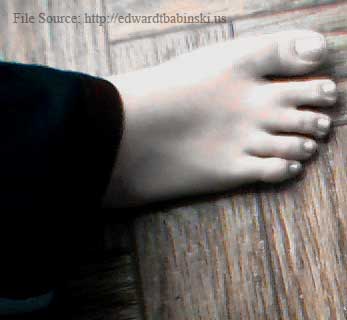

12 Genes within the HOXD cluster and locus chr2q31 seem to be involved in syndactyly 13: the HOXD13 gene, for example, is linked to syndactyly type V (SD5) and a brachydactyly-syndactyly syndrome. Thirty-nine HOX genes exist in humans the HOXA and HOXD clusters have been associated with syndactyly and polydactyly. The HOX genes, hedgehog pathways, FGFs, bone morphogenetic proteins (BMPs), and cartilage-derived morphogenetic proteins are also involved. 10 Aside from the ZPA, which is on the posterior embryo and produces fibroblast growth factor 8 (FGF8), the apical ectodermal ridge, which is on the dorsal-ventral margin and produces FGF8, also aids in limb development. 6–9 The ZPA disappears by day 44 of embryonic development, after which time the phalanges form. The genes involved in syndactyly and polydactyly tend to affect specific bodily regions, including the zone of polarizing activity (ZPA): an area that controls limb structure and positional identity. New causative genes and mutations are being discovered with advances in sequencing technology.

Given the aforementioned morphological variation, it is not surprising that the genetic bases of syndactyly and polydactyly are diverse, polygenic, 5 and as yet unclear in some cases. This study reviews the current knowledge on the genetics of these anomalies. Though syndactyly and polydactyly are phenotypically well understood, their genetic bases have not been synthesized in writing and remain unclear for some types. Like syndactyly, polydactyly is phenotypically variable 3 in terms of the limb affected (hand or foot), 4 its severity, and its syndromicity or lack thereof. Polydactyly is another hereditary limb malformation, characterized by supernumerary digits (ie, more than 5 digits per limb). Even a single patient’s phenotype may be severe or mild, unilateral or bilateral, symmetrical or asymmetrical, complete or incomplete, cutaneous or bony, and involving many distinct bones, with inter-limb phenotypic variation. 2 It also varies phenotypically between families. 1 It can be syndromic, comprising more than 300 distinct anomalies, 1 or nonsyndromic, existing as 1 of 9 nonsyndromic forms. Syndactyly (ie, digit fusion, typically via webbing) is a common inherited and clinically heterogeneous malformation. Then, having established a summation of existing and missing knowledge, this work briefly outlines the diagnostic techniques that a genetics-reinforced understanding of syndactyly and polydactyly could inform. This review thus attempts to collect all that is known about the genetic bases of syndromic and nonsyndromic syndactylies and polydactylies, as well as to highlight the dactyly manifestations for which no genetic bases are as yet known. This gap in the literature problematizes comprehensive carrier screening and prenatal diagnosis and complicates novel diagnostic attempts. Further, even though concrete knowledge of genotypic links has been established for some variants of syndactyly and polydactyly, there appears to be no single comprehensive published summary of all syndromic and nonsyndromic syndactyly and polydactyly presentations, and there is decidedly no resource that maps all syndromic and nonsyndromic syndactylies and polydactylies to their genetic bases. Despite their relatively regular manifestation in the clinic, the etiologies of syndactyly and polydactyly remain poorly understood because of their phenotypic and genetic diversity. Syndactyly and polydactyly-respectively characterized by fused and supernumerary digits-are among the most common congenital limb malformations, with syndactyly presenting at an estimated incidence of 1 in 2,000–3,000 live births and polydactyly at a frequency of 1 in approximately 700–1,000 live births. The work cannot be changed in any way or used commercially without permission from the journal.
HUMAN WEBBED FEET LICENSE
This is an open-access article distributed under the terms of the Creative Commons Attribution-Non Commercial-No Derivatives License 4.0 (CCBY-NC-ND), where it is permissible to download and share the work provided it is properly cited. Akbari, MD, PhD, 76 Grenville St., Room 6421, Toronto, ON, M5S 1B2, Canada, E-mail: The Article Processing Charge was paid for by the authors. Received for publication Maaccepted September 6, 2017.ĭisclosure: The authors have no financial interest to declare in relation to the content of this article. From the *Women’s College Research Institute, Women’s College Hospital, University of Toronto, Toronto, Canada †Institute of Medical Science, University of Toronto, Toronto, Canada ‡Department of Plastic and Reconstructive Surgery, Hazrat Fatemeh Hospital, Burn Research Center, Iran University of Medical Sciences, Tehran, Iran and §Dalla Lana School of Public Health, University of Toronto, Toronto, Canada.


 0 kommentar(er)
0 kommentar(er)
